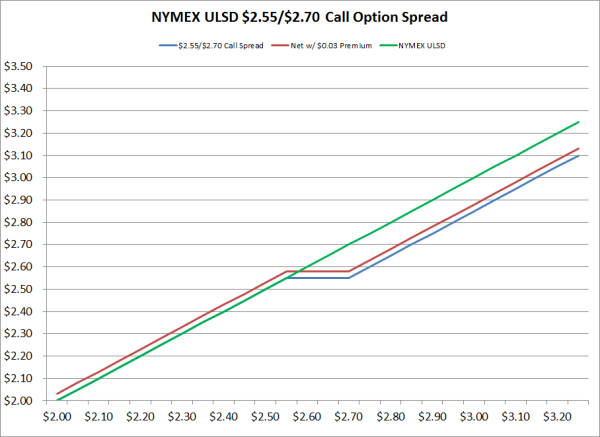A Beginners Guide to Fuel Hedging
Post on: 10 Май, 2015 No Comment

A Beginners Guide to Fuel Hedging — Futures
As a result of the recent spike in fuel prices (as an example, RBOB gasoline futures are up 20% since bottoming at $2.55 on June 21st), our phones have been ringing quite often this week as many companies are trying to develop a fuel hedging strategy. If you’re lacking the knowledge to consider yourself a fuel hedging expert, this post, along with several more that we’ll be publishing in the coming weeks, will help you better obtain a better understanding of the fundamentals of fuel hedging.
So what is a futures contract? A futures contract is simply a standardized contract between two parties to buy or sell a specific quantity and quality of a commodity for a price agreed upon at the time the transaction takes place, with delivery and payment occurring at a specified future date . The contracts are negotiated on a futures exchange, such as NYMEX or ICE. which acts as a neutral intermediary between the buyer and seller. The party agreeing to buy the futures contract, the buyer, is said to be long the futures while the party agreeing to sell the futures contract, the seller of the contract, is said to be short the futures.
In essence, a futures contract obligates the buyer of the contract to buy the underlying commodity at the price at which he bought the futures contract. Similarly, a futures contract also obligates the seller of the contract to sell the underlying commodity at the price at which he sold the futures contract. That being said, in practice, very few futures contracts actually result in delivery, as most are utilized for hedging and are bought back or sold back prior to expiration.
There are five primary futures contracts which are commonly used for fuel hedging. WTI crude oil, heating oil and RBOB gasoline, which are traded on NYMEX and Brent crude oil and gasoil, which are traded on ICE. Regardless of whether you’re looking at hedging bunker, diesel fuel, gasoline, jet fuel or any other refined product, these five contracts serve as the primary benchmarks across the globe.
So how can you utilize futures contracts to hedge your exposure to rising fuel prices?
Let’s assume that your company owns/leases a large fleet of vehicles and, to ensure that your fuel costs do not exceed your budgeted fuel price, you have been asked to fix or lock in the price of your anticipated fuel consumption. For sake of simplicity, let’s assume that you are looking to hedge (by fixing or locking in the price) 42,000 gallons of gasoline which you anticipate consuming in October 2012. To hedge said gasoline, you could purchase one October RBOB gasoline futures contract, which happens to trade in 42,000 gallon increments. As an aside, 42,000 gallons equates to 1,000 barrels. If you had purchased this contract based on the closing price yesterday, you could have hedged your October gasoline consumption at approximately $2.90/gallon.
Fast forward to September 28, 2012, the expiration date of the October RBOB gasoline futures contract. Because you do not want to take delivery of 42,000 gallons of gasoline in New York Harbor, the delivery point of the NYMEX RBOB futures contract, you decide to close out your position by selling back one October RBOB gasoline futures contract at the then, prevailing market price.
In scenario one, let’s assume that the prevailing market price, at which you sold back the futures, was $3.50/gallon. In this scenario, your gain on the futures contract would equate to a profit of $0.60/gallon. However, because you are not taking delivery of the futures contract, the price you pay at the pump will be $3.50 per gallon, although your net cost (excluding transportation and distribution fees, your suppliers profit margin, taxes, etc.) will be $2.90/gallon as a result of the $0.60/gallon gain on the futures contract.
In scenario two, let’s assume that the prevailing market price, at which you sold back the futures, was $2.00/gallon. In this scenario, your loss on the futures contract would equate to a loss of $0.90/gallon. However, as was in the case in scenario one, because you are not taking delivery of the futures contract, the price you pay at the pump will be $2.00 per gallon. As a result of the loss on the futures contract, your net cost (excluding transportation and distribution fees, your suppliers profit margin, taxes, etc.) will be $2.90/gallon due to the $0.90/gallon loss on the futures contract.
As these examples indicate, purchasing a gasoline futures contract provides you with the ability to hedge/fix/lock in your anticipated gasoline costs for a specific month(s), regardless of whether the gasoline futures price increase or decreases between the time you purchase it and the date the futures contract expires.
While we explored hedging with gasoline futures in this example, the same methodology applies to hedging with heating oil, gasoil and crude oil futures.
While there are many details that need to be considered before buying or selling a futures contract, the basic methodology of hedging fuel price risk with futures is pretty simple. That is, if you need to hedge your exposure to potentially rising fuel prices you can do so by purchasing a futures contract on gasoline, heating oil, gasoil or crude oil. Similarly, if you need to hedge your exposure to declining fuel fuel prices, you can do so by selling a futures contract.
UPDATE: This article is the first in the series titled A Beginners Guide to Fuel Hedging. The subsequent posts in the series can be found via the following links:














